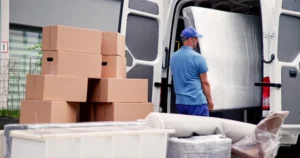How to prepare furniture for long distance moving starts with understanding the challenges involved like the risk of damage, furniture shifting during transit, and maneuvering large pieces through tight doorways or hallways. A long-distance move requires more than just basic packing; it needs detailed planning to prevent unnecessary damage or delays. Preparing your furniture properly helps ensure it stays intact, protected, and ready to use when it reaches your new home.
Without taking the right steps, you could end up dealing with scratches, broken parts, or even major repairs. From using the right packing supplies to applying proven wrapping and securing techniques, this guide will cover everything you need to know to move your furniture safely and efficiently. With careful preparation, your move can be smooth and worry-free.
Why Preparing Furniture for Long-Distance Moving is Important

When you’re moving furniture a long way, getting it ready the right way is very important. Here’s why:
1. Avoiding Damage on the Road
Long-distance moves can be rough on your furniture. The truck may hit bumps, roads can be uneven, and your items may shift around. Also, changes in weather (like heat, cold, or moisture) can affect wood, fabric, or metal. Furniture might become scratched, broken, or bent if it is not packed and protected properly.
2. Poor Packing Can Cost You
If furniture gets damaged because it wasn’t packed well, you might have to spend a lot of money fixing or replacing it. Movers may also charge more if packing takes longer or if your items aren’t ready to load. This means extra costs you didn’t plan for.
3. Good Prep Saves Time and Money
When your furniture is properly prepared wrapped, disassembled if needed, and labeled it’s easier and faster for movers to load and unload. This can reduce labor costs and prevent delays. Plus, it gives you peace of mind knowing your furniture is safe.
Essential Furniture Moving Supplies
When preparing for a major move, having the right furniture moving supplies is crucial. The proper tools not only make the process more manageable but also help protect your belongings from damage. Here’s a breakdown of essential supplies every mover should have:
Moving Blankets and Furniture Pads
These thick, padded covers are vital for protecting furniture surfaces from scratches, dents, and other damage during transport. They’re particularly important for fragile or wooden items.
Bubble Wrap and Plastic Stretch Wrap
Bubble wrap provides cushioning for delicate surfaces, while stretch wrap helps keep furniture components like doors, drawers, and cushions securely in place. It also acts as a barrier against dust and moisture.
Furniture Sliders and Hand Trucks (Dollies)
Furniture sliders allow you to glide heavy items across floors without causing scuffs or scratches. A hand truck or dolly makes moving large or bulky furniture easier and helps prevent injuries.
Heavy-Duty Packing Tape and Tie-Down Straps
Durable packing tape is necessary for securing wrapping materials and sealing boxes. Tie-down straps help keep furniture stable and in place inside the moving truck, reducing the risk of shifting during transport.
Edge and Corner Protectors
These provide extra protection for vulnerable edges on mirrors, tables, and dressers, preventing chips, cracks, or dents especially when moving through narrow spaces or tight doorways.
Labeled Boxes and Ziplock Bags for Small Hardware
Use small resealable bags to store screws, bolts, and other hardware from disassembled furniture. Label each bag clearly and either tape it to the furniture piece or place it in a marked box so everything stays organized and easy to find during reassembly.
With these essential supplies, your move will be safer, smoother, and more efficient helping you protect your investment in your furniture every step of the way.
Step-by-Step | How to Prepare Furniture for Long-Distance Moving

Properly getting your furniture ready is one of the most important parts of a successful long-distance move. In this step-by-step guide, we’ll walk you through exactly how to prepare furniture for long-distance moving so it stays safe and damage-free during the trip.
1. Take Inventory
Before you do anything else, make a complete list of all the furniture you’re moving. Write down the name and condition of each item.
- Tip: Take clear photos of each piece. This helps with organization and is useful for insurance if anything gets damaged.
2. Clean and Disassemble Furniture
A clean surface prevents dirt and mold from spreading during the move.
- Clean thoroughly: Wipe down all surfaces to remove dust, grime, or moisture. This is especially important for upholstered or wooden furniture.
- Disassemble parts: Remove legs from tables and chairs, take off cushions, remove shelves, and detach glass tops. This makes the furniture easier to pack and less likely to break.
- Keep small parts safe: Hardware, bolts, and screws should be taped to the appropriate piece of furniture and kept in ziplock bags with labels.
3. Protect Fragile Components
Fragile elements of furniture require special attention when preparing for long-distance moving.
- Wrap glass and delicate surfaces with bubble wrap and secure them with tape.
- Use furniture blankets or pads to cushion larger items.
- Label fragile items like mirrors, glass panels, or delicate finishes so movers know to handle them with care.
4. Wrap and Secure Everything
Once your furniture is clean and disassembled, it’s time to wrap and secure it.
- Use stretch wrap to hold loose pieces in place and protect against dust and moisture.
- Cover larger items with moving blankets or pads. This keeps dents and scrapes at bay while being transported.
- Tape everything down carefully, avoiding direct contact with wooden or painted surfaces to prevent damage.
Best Ways to Pack Furniture for Moving
Packing your furniture properly is one of the most important steps to ensure a safe and damage-free move especially during long-distance relocations. Using the right techniques not only protects your belongings but also saves time during loading and unpacking. Here’s a practical guide to the best ways to pack furniture for moving:
1. Follow a Room-by-Room Packing Plan
One of the smartest ways to stay organized during a move is by packing furniture room by room. This method helps streamline the process, prevents confusion, and makes unloading and setting up much easier.
- Begin with less frequently used spaces such as guest rooms, basements, or storage areas.
- Clearly label each piece or package with the name of the room it came from.
- Group similar items together for easier loading and better space management in the moving truck.
2. Use Furniture-Specific Packing Techniques
Each type of furniture requires different handling and wrapping techniques to keep it safe during transit. Here’s how to pack various furniture types correctly:
- Beds: Disassemble the frame and wrap headboards and footboards in moving blankets. Store all screws, bolts, and small parts in labeled ziplock bags and attach them securely to the frame.
- Sofas and Couches: Remove all cushions and wrap them individually. Use stretch wrap or moving blankets to protect the entire frame from dirt, rips, and stains.
- Tables: If possible, detach the legs and wrap them separately. Use corner guards to protect vulnerable edges, and cover the tabletop with padded blankets or bubble wrap.
- Chairs: Wrap the legs, arms, and backrest with padding or blankets. Lightweight chairs can be stacked carefully, using protective material in between to prevent damage.
- Dressers and Cabinets: Take out drawers and wrap them individually, or secure them in place with stretch wrap to prevent sliding during the move.
3. Avoid These Common Packing Mistakes
Even with the best intentions, small oversights can lead to damage. Avoid these common furniture packing mistakes to keep your items safe:
- Never place heavy furniture on top of lighter items. This can result in crushed pieces or broken legs.
- Don’t skip padding. Even sturdy furniture needs protection from scratches, dents, and movement during transit.
- Keep hardware secured. Small screws and connectors can easily get lost always store them in labeled bags and tape them to their matching furniture.
- Avoid wrapping wood in plastic directly. This may cause the finish to deteriorate by retaining moisture. Always use a fabric layer like a moving blanket between wood surfaces and plastic wrap.
How to Protect Furniture When Moving?
Moving furniture can be tricky, especially when you’re dealing with large, heavy, or delicate items. Wondering how to protect furniture when moving? With the right tools and techniques, you can keep your furniture safe from damage during transport. Here’s a helpful guide to doing it the right way.
1. Use Moving Blankets and Padding Strategically
One of the best answers to “how to protect furniture when moving?” is using the right protective materials.
- Wrap furniture completely with thick moving blankets or pads to prevent scratches, dents, and dirt buildup.
- Use bubble wrap or foam for delicate items like glass tops, mirrors, or decorative woodwork.
- Secure the padding with packing tape or stretch wrap, but avoid placing tape directly on wood or fabric.
2. Weatherproof Your Furniture for Transport
Weather can change quickly, especially during long-distance moves, so protecting against moisture and temperature changes is key.
- Use plastic covers or stretch wrap to shield items from rain or humidity.
- Wrap wooden furniture well to prevent swelling or cracking due to changes in temperature.
- Avoid leaving furniture outside for long periods during loading or unloading.
3. Tips for Safe Handling and Loading
Proper handling and loading are just as important as wrapping and padding. Here’s how to keep things safe and organized:
- Use dollies and moving straps to move heavy or bulky furniture. This prevents injury and protects the furniture from being dropped.
- Load heavy furniture first so it stays at the bottom of the truck and doesn’t crush lighter pieces.
- Label items clearly with the room name and note anything fragile. This helps movers place everything correctly and handle with care.
Final Thoughts
Preparing furniture for long-distance moving is all about planning, protecting, and packing the right way. From wrapping with blankets to using the proper tools, every step helps prevent damage and save time. If you’re looking for moving services in Los Angeles, Chamomile Go is here to help. Our expert team handles your furniture with care from start to finish. Contact us today and make your move simple, safe, and stress-free!
FAQs
Why Is It Important To Prepare Furniture Before A Long-Distance Move?
Proper preparation helps prevent damage during transport, reduces moving costs, and makes loading and unloading more efficient.
What Are The First Steps In Preparing Furniture For A Long Move?
Start by taking inventory, cleaning each piece, and disassembling items like beds, tables, and chairs. Store small parts in labeled bags.
How Do I Protect Fragile Furniture Pieces?
Use bubble wrap, moving blankets, and corner protectors. Label fragile items clearly so movers handle them with care.
Should I Disassemble All My Furniture?
Only disassemble large or bulky items that are easier to move in parts like bed frames or dining tables. Keep hardware in ziplock bags.
What Supplies Do I Need To Pack Furniture For A Long-Distance Move?
You’ll need moving blankets, stretch wrap, bubble wrap, packing tape, dollies, sliders, and furniture straps.








